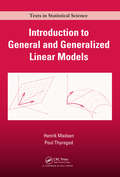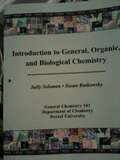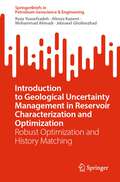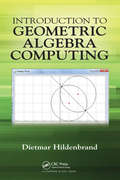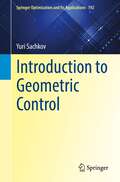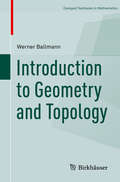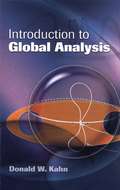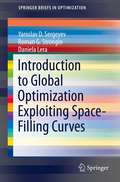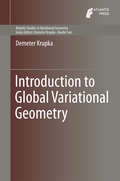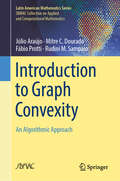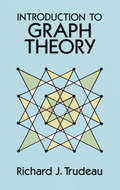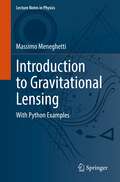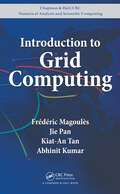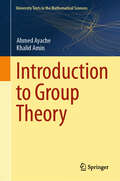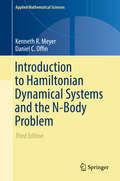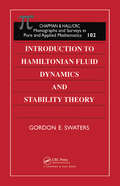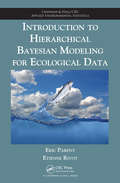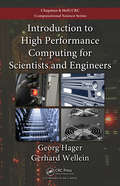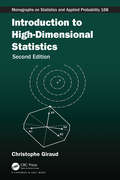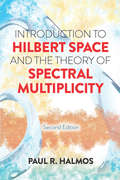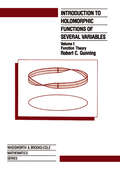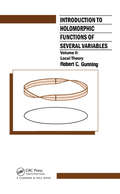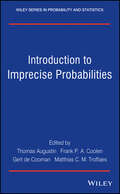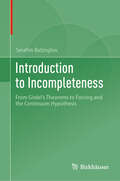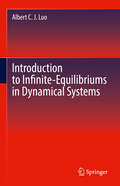- Table View
- List View
Introduction to General and Generalized Linear Models (Chapman & Hall/CRC Texts in Statistical Science)
by Henrik Madsen Poul ThyregodBridging the gap between theory and practice for modern statistical model building, Introduction to General and Generalized Linear Models presents likelihood-based techniques for statistical modelling using various types of data. Implementations using R are provided throughout the text, although other software packages are also discussed. Numerous
Introduction to General, Organic and Biological Chemistry
by Charles Solomon Susan Sally Rutkowsky BortizIntroduction to General, Organic, and Biological Chemistry
Introduction to Geological Uncertainty Management in Reservoir Characterization and Optimization: Robust Optimization and History Matching (SpringerBriefs in Petroleum Geoscience & Engineering)
by Jebraeel Gholinezhad Reza Yousefzadeh Alireza Kazemi Mohammad AhmadiThis book explores methods for managing uncertainty in reservoir characterization and optimization. It covers the fundamentals, challenges, and solutions to tackle the challenges made by geological uncertainty. The first chapter discusses types and sources of uncertainty and the challenges in different phases of reservoir management, along with general methods to manage it. The second chapter focuses on geological uncertainty, explaining its impact on field development and methods to handle it using prior information, seismic and petrophysical data, and geological parametrization. The third chapter deals with reducing geological uncertainty through history matching and the various methods used, including closed-loop management, ensemble assimilation, and stochastic optimization. The fourth chapter presents dimensionality reduction methods to tackle high-dimensional geological realizations. The fifth chapter covers field development optimization using robust optimization, including solutions for its challenges such as high computational cost and risk attitudes. The final chapter introduces different types of proxy models in history matching and robust optimization, discussing their pros and cons, and applications. The book will be of interest to researchers and professors, geologists and professionals in oil and gas production and exploration.
Introduction to Geometric Algebra Computing: Computing with Circles and Lines (Computer Vision Series)
by Dietmar HildenbrandFrom the Foreword: "Dietmar Hildenbrand's new book, Introduction to Geometric Algebra Computing, in my view, fills an important gap in Clifford's geometric algebra literature…I can only congratulate the author for the daring simplicity of his novel educational approach taken in this book, consequently combined with hands on computer based exploration. Without noticing, the active reader will thus educate himself in elementary geometric algebra algorithm development, geometrically intuitive, highly comprehensible, and fully optimized." --Eckhard Hitzer, International Christian University, Tokyo, Japan Geometric Algebra is a very powerful mathematical system for an easy and intuitive treatment of geometry, but the community working with it is still very small. The main goal of this book is to close this gap with an introduction to Geometric Algebra from an engineering/computing perspective. This book is intended to give a rapid introduction to computing with Geometric Algebra and its power for geometric modeling. From the geometric objects point of view, it focuses on the most basic ones, namely points, lines and circles. This algebra is called Compass Ruler Algebra, since it is comparable to working with a compass and ruler. The book explores how to compute with these geometric objects, and their geometric operations and transformations, in a very intuitive way. The book follows a top-down approach, and while it focuses on 2D, it is also easily expandable to 3D computations. Algebra in engineering applications such as computer graphics, computer vision and robotics are also covered.
Introduction to Geometric Control (Springer Optimization and Its Applications #192)
by Yuri SachkovThis text is an enhanced, English version of the Russian edition, published in early 2021 and is appropriate for an introductory course in geometric control theory. The concise presentation provides an accessible treatment of the subject for advanced undergraduate and graduate students in theoretical and applied mathematics, as well as to experts in classic control theory for whom geometric methods may be introduced. Theory is accompanied by characteristic examples such as stopping a train, motion of mobile robot, Euler elasticae, Dido's problem, and rolling of the sphere on the plane. Quick foundations to some recent topics of interest like control on Lie groups and sub-Riemannian geometry are included. Prerequisites include only a basic knowledge of calculus, linear algebra, and ODEs; preliminary knowledge of control theory is not assumed. The applications problems-oriented approach discusses core subjects and encourages the reader to solve related challenges independently. Highly-motivated readers can acquire working knowledge of geometric control techniques and progress to studying control problems and more comprehensive books on their own. Selected sections provide exercises to assist in deeper understanding of the material.Controllability and optimal control problems are considered for nonlinear nonholonomic systems on smooth manifolds, in particular, on Lie groups. For the controllability problem, the following questions are considered: controllability of linear systems, local controllability of nonlinear systems, Nagano–Sussmann Orbit theorem, Rashevskii–Chow theorem, Krener's theorem. For the optimal control problem, Filippov's theorem is stated, invariant formulation of Pontryagin maximum principle on manifolds is given, second-order optimality conditions are discussed, and the sub-Riemannian problem is studied in detail. Pontryagin maximum principle is proved for sub-Riemannian problems, solution to the sub-Riemannian problems on the Heisenberg group, the group of motions of the plane, and the Engel group is described.
Introduction to Geometry and Topology (Compact Textbooks in Mathematics)
by Werner Ballmann Walker SternThis book provides an introduction to topology, differential topology, and differential geometry. It is based on manuscripts refined through use in a variety of lecture courses. The first chapter covers elementary results and concepts from point-set topology. An exception is the Jordan Curve Theorem, which is proved for polygonal paths and is intended to give students a first glimpse into the nature of deeper topological problems. The second chapter of the book introduces manifolds and Lie groups, and examines a wide assortment of examples. Further discussion explores tangent bundles, vector bundles, differentials, vector fields, and Lie brackets of vector fields. This discussion is deepened and expanded in the third chapter, which introduces the de Rham cohomology and the oriented integral and gives proofs of the Brouwer Fixed-Point Theorem, the Jordan-Brouwer Separation Theorem, and Stokes's integral formula. The fourth and final chapter is devoted to the fundamentals of differential geometry and traces the development of ideas from curves to submanifolds of Euclidean spaces. Along the way, the book discusses connections and curvature--the central concepts of differential geometry. The discussion culminates with the Gauß equations and the version of Gauß's theorema egregium for submanifolds of arbitrary dimension and codimension. This book is primarily aimed at advanced undergraduates in mathematics and physics and is intended as the template for a one- or two-semester bachelor's course.
Introduction to Global Analysis
by Donald W. KahnThis accessible introduction to global analysis begins with a basic discussion of finite-dimensional differential manifolds. A Professor of Mathematics at the University of Minnesota, author Donald W. Kahn has geared his treatment toward advanced undergraduates and graduate students. Starting with those aspects that flow from the usual advanced calculus, he proceeds to proofs of versions of the Whitney embedding theorem, the theorem of Sard on the measure of the set of critical values, and the transversality lemma of Thom.With the foundations set, the text turns to examinations of the tangent bundle to a manifold and the general theory of vector bundles. A study of differential operators on manifolds follows, including the algebra of differential forms, Stokes' theorem, the Poincaré lemma, and the basic definition of deRham cohomology. Additional topics include infinite-dimensional manifolds, Morse theory, Lie groups, dynamical systems, and the roles of singularities and catastrophes. Each chapter concludes with a selection of problems and projects.
Introduction to Global Optimization Exploiting Space-Filling Curves
by Yaroslav D. Sergeyev Daniela Lera Roman G. StronginIntroduction to Global Optimization Exploiting Space-Filling Curves provides an overview of classical and new results pertaining to the usage of space-filling curves in global optimization. The authors look at a family of derivative-free numerical algorithms applying space-filling curves to reduce the dimensionality of the global optimization problem; along with a number of unconventional ideas, such as adaptive strategies for estimating Lipschitz constant, balancing global and local information to accelerate the search. Convergence conditions of the described algorithms are studied in depth and theoretical considerations are illustrated through numerical examples. This work also contains a code for implementing space-filling curves that can be used for constructing new global optimization algorithms. Basic ideas from this text can be applied to a number of problems including problems with multiextremal and partially defined constraints and non-redundant parallel computations can be organized. Professors, students, researchers, engineers, and other professionals in the fields of pure mathematics, nonlinear sciences studying fractals, operations research, management science, industrial and applied mathematics, computer science, engineering, economics, and the environmental sciences will find this title useful .
Introduction to Global Variational Geometry
by Demeter KrupkaThe book is devoted to recent research in the global variational theory on smooth manifolds. Its main objective is an extension of the classical variational calculus on Euclidean spaces to (topologically nontrivial) finite-dimensional smooth manifolds; to this purpose the methods of global analysis of differential forms are used. Emphasis is placed on the foundations of the theory of variational functionals on fibered manifolds - relevant geometric structures for variational principles in geometry, physical field theory and higher-order fibered mechanics. The book chapters include: - foundations of jet bundles and analysis of differential forms and vector fields on jet bundles, - the theory of higher-order integral variational functionals for sections of a fibred space, the (global) first variational formula in infinitesimal and integral forms- extremal conditions and the discussion of Noether symmetries and generalizations, - the inverse problems of the calculus of variations of Helmholtz type- variational sequence theory and its consequences for the global inverse problem (cohomology conditions)- examples of variational functionals of mathematical physics. Complete formulations and proofs of all basic assertions are given, based on theorems of global analysis explained in the Appendix
Introduction to Graph Convexity: An Algorithmic Approach (Latin American Mathematics Series)
by Júlio Araújo Mitre C. Dourado Fábio Protti Rudini M. SampaioThis book focuses on the computational aspects of graph convexity, with a particular emphasis on path convexity within graphs. It provides a thoughtful introduction to this emerging research field, which originated by adapting concepts from convex geometry to combinatorics and has experienced substantial growth. The book starts with an introduction of fundamental convexity concepts and then proceeds to discuss convexity parameters. These parameters fall into two categories: one derived from abstract convexity studies and another motivated by computational complexity. Subsequent chapters explore geometric convexity within graphs, examining various graph classes such as interval graphs, proper interval graphs, cographs, chordal graphs, and strongly chordal graphs. The text concludes with a study of the computation of convexity parameters across different convexity types, including practical applications in areas like game theory. Compact and straightforward, this work serves as an ideal entry point for students and researchers interested in pursuing further research in the field of convexity. The English translation of this book, originally in Portuguese, was facilitated by artificial intelligence. The content was later revised by the authors for accuracy.
Introduction to Graph Theory
by Richard J. TrudeauAimed at "the mathematically traumatized," this text offers nontechnical coverage of graph theory, with exercises. Discusses planar graphs, Euler's formula, Platonic graphs, coloring, the genus of a graph, Euler walks, Hamilton walks, more. 1976 edition.
Introduction to Gravitational Lensing: With Python Examples (Lecture Notes in Physics #956)
by Massimo MeneghettiThis book introduces the phenomenology of gravitational lensing in an accessible manner and provides a thorough discussion of the related astrophysical applications. It is intended for advanced undergraduates and graduate students who want to start working in this rapidly evolving field. This includes also senior researchers who are interested in ongoing or future surveys and missions such as DES, Euclid, WFIRST, LSST. The reader is guided through many fascinating topics related to gravitational lensing like the structure of our galaxy, the searching for exoplanets, the investigation of dark matter in galaxies and galaxy clusters, and several aspects of cosmology, including dark energy and the cosmic microwave background. The author, who has gained valuable experience as academic teacher, guides the readers towards the comprehension of the theory of gravitational lensing and related observational techniques by using simple codes written in python. This approach, beyond facilitating the understanding of gravitational lensing, is preparatory for learning the python programming language which is gaining large popularity both in academia and in the private sector.
Introduction to Grid Computing (Chapman & Hall/CRC Numerical Analysis and Scientific Computing Series)
by Frederic Magoules Jie Pan Kiat-An Tan Abhinit KumarA Thorough Overview of the Next Generation in ComputingPoised to follow in the footsteps of the Internet, grid computing is on the verge of becoming more robust and accessible to the public in the near future. Focusing on this novel, yet already powerful, technology, Introduction to Grid Computing explores state-of-the-art grid projects, core grid
Introduction to Group Theory (University Texts in the Mathematical Sciences)
by Ahmed Ayache Khalid AminTargeted at undergraduate mathematics students, this book aims to cover courses in group theory. Based on lectures in group theory, it includes many illustrations and examples, numerous solved exercises and detailed proofs of theorems. The book acts as a guide to teachers and is also useful to graduate students. The book discusses major topics in group theory such as groups and subgroups, binary operations, fundamental algebraic structure of groups, symmetric groups, cyclic groups, normal subgroups, quotient groups, homomorphisms, isomorphisms, direct product of groups, simple groups, set on a group, Sylow's theorem, finite group, Abelian groups and non-isomorphic Abelian groups.
Introduction to Hamiltonian Dynamical Systems and the N-Body Problem
by Kenneth R. Meyer Daniel C. OffinThis third edition text provides expanded material on the restricted three body problem and celestial mechanics. With each chapter containing new content, readers are provided with new material on reduction, orbifolds, and the regularization of the Kepler problem, all of which are provided with applications. The previous editions grew out of graduate level courses in mathematics, engineering, and physics given at several different universities. The courses took students who had some background in differential equations and lead them through a systematic grounding in the theory of Hamiltonian mechanics from a dynamical systems point of view.This text provides a mathematical structure of celestial mechanics ideal for beginners, and will be useful to graduate students and researchers alike. Reviews of the second edition:"The primary subject here is the basic theory of Hamiltonian differential equations studied from the perspective of differential dynamical systems. The N-body problem is used as the primary example of a Hamiltonian system, a touchstone for the theory as the authors develop it. This book is intended to support a first course at the graduate level for mathematics and engineering students. … It is a well-organized and accessible introduction to the subject … . This is an attractive book … ." (William J. Satzer, The Mathematical Association of America, March, 2009) “The second edition of this text infuses new mathematical substance and relevance into an already modern classic … and is sure to excite future generations of readers. … This outstanding book can be used not only as an introductory course at the graduate level in mathematics, but also as course material for engineering graduate students. … it is an elegant and invaluable reference for mathematicians and scientists with an interest in classical and celestial mechanics, astrodynamics, physics, biology, and related fields.” (Marian Gidea, Mathematical Reviews, Issue 2010 d)
Introduction to Hamiltonian Fluid Dynamics and Stability Theory (Monographs And Surveys In Pure And Applied Mathematics Ser. #102)
by Gordon E SwatersHamiltonian fluid dynamics and stability theory work hand-in-hand in a variety of engineering, physics, and physical science fields. Until now, however, no single reference addressed and provided background in both of these closely linked subjects. Introduction to Hamiltonian Fluid Dynamics and Stability Theory does just that-offers a comprehensive introduction to Hamiltonian fluid dynamics and describes aspects of hydrodynamic stability theory within the context of the Hamiltonian formalism.The author uses the example of the nonlinear pendulum-giving a thorough linear and nonlinear stability analysis of its equilibrium solutions-to introduce many of the ideas associated with the mathematical argument required in infinite dimensional Hamiltonian theory needed for fluid mechanics. He examines Andrews' Theorem, derives and develops the Charney-Hasegawa-Mima (CMH) equation, presents an account of the Hamiltonian structure of the Korteweg-de Vries (KdV) equation, and discusses the stability theory associated with the KdV soliton.The book's tutorial approach and plentiful exercises combine with its thorough presentations of both subjects to make Introduction to Hamiltonian Fluid Dynamics and Stability Theory an ideal reference, self-study text, and upper level course book.
Introduction to Hierarchical Bayesian Modeling for Ecological Data (Chapman & Hall/CRC Applied Environmental Statistics)
by Eric Parent Etienne RivotMaking statistical modeling and inference more accessible to ecologists and related scientists, Introduction to Hierarchical Bayesian Modeling for Ecological Data gives readers a flexible and effective framework to learn about complex ecological processes from various sources of data. It also helps readers get started on building their own statisti
Introduction to High Performance Computing for Scientists and Engineers (Chapman & Hall/CRC Computational Science)
by Georg Hager Gerhard WelleinWritten by high performance computing (HPC) experts, Introduction to High Performance Computing for Scientists and Engineers provides a solid introduction to current mainstream computer architecture, dominant parallel programming models, and useful optimization strategies for scientific HPC. From working in a scientific computing center, the author
Introduction to High-Dimensional Statistics (Chapman & Hall/CRC Monographs on Statistics and Applied Probability #138)
by Christophe GiraudPraise for the first edition: "[This book] succeeds singularly at providing a structured introduction to this active field of research. … it is arguably the most accessible overview yet published of the mathematical ideas and principles that one needs to master to enter the field of high-dimensional statistics. … recommended to anyone interested in the main results of current research in high-dimensional statistics as well as anyone interested in acquiring the core mathematical skills to enter this area of research."—Journal of the American Statistical Association Introduction to High-Dimensional Statistics, Second Edition preserves the philosophy of the first edition: to be a concise guide for students and researchers discovering the area and interested in the mathematics involved. The main concepts and ideas are presented in simple settings, avoiding thereby unessential technicalities. High-dimensional statistics is a fast-evolving field, and much progress has been made on a large variety of topics, providing new insights and methods. Offering a succinct presentation of the mathematical foundations of high-dimensional statistics, this new edition: Offers revised chapters from the previous edition, with the inclusion of many additional materials on some important topics, including compress sensing, estimation with convex constraints, the slope estimator, simultaneously low-rank and row-sparse linear regression, or aggregation of a continuous set of estimators. Introduces three new chapters on iterative algorithms, clustering, and minimax lower bounds. Provides enhanced appendices, minimax lower-bounds mainly with the addition of the Davis-Kahan perturbation bound and of two simple versions of the Hanson-Wright concentration inequality. Covers cutting-edge statistical methods including model selection, sparsity and the Lasso, iterative hard thresholding, aggregation, support vector machines, and learning theory. Provides detailed exercises at the end of every chapter with collaborative solutions on a wiki site. Illustrates concepts with simple but clear practical examples.
Introduction to Hilbert Space and the Theory of Spectral Multiplicity: Second Edition (Dover Books on Mathematics #82)
by Paul R. HalmosThis concise introductory treatment consists of three chapters: The Geometry of Hilbert Space, The Algebra of Operators, and The Analysis of Spectral Measures. Author Paul R. Halmos notes in the Preface that his motivation in writing this text was to make available to a wider audience the results of the third chapter, the so-called multiplicity theory. The theory as he presents it deals with arbitrary spectral measures, including the multiplicity theory of normal operators on a not necessarily separable Hilbert space. His explication covers, as another useful special case, the multiplicity theory of unitary representations of locally compact abelian groups.Suitable for advanced undergraduates and graduate students in mathematics, this volume's sole prerequisite is a background in measure theory. The distinguished mathematician E. R. Lorch praised the book in the Bulletin of the American Mathematical Society as "an exposition which is always fresh, proofs which are sophisticated, and a choice of subject matter which is certainly timely."
Introduction to Holomorphic Functions of Several Variables, Volume I: Homological Theory
by R.C. GunningIntroduction to Holomorphlc Functions of SeveralVariables, Volumes 1-111 provide an extensiveintroduction to the Oka-Cartan theory of holomorphicfunctions of several variables and holomorphicvarieties. Each volume covers a different aspect andcan be read independently.
Introduction to Holomorphic Functions of Several Variables, Volume II: Homological Theory
by R.C. GunningIntroduction to Holomorphlc Functions of SeveralVariables, Volumes 1-111 provide an extensiveintroduction to the Oka-Cartan theory of holomorphicfunctions of several variables and holomorphicvarieties. Each volume covers a different aspect andcan be read independently.
Introduction to Imprecise Probabilities
by Gert De Cooman Matthias C. Troffaes Frank P. Coolen Thomas AugustinIn recent years, the theory has become widely accepted and has been further developed, but a detailed introduction is needed in order to make the material available and accessible to a wide audience. This will be the first book providing such an introduction, covering core theory and recent developments which can be applied to many application areas. All authors of individual chapters are leading researchers on the specific topics, assuring high quality and up-to-date contents.An Introduction to Imprecise Probabilities provides a comprehensive introduction to imprecise probabilities, including theory and applications reflecting the current state if the art. Each chapter is written by experts on the respective topics, including: Sets of desirable gambles; Coherent lower (conditional) previsions; Special cases and links to literature; Decision making; Graphical models; Classification; Reliability and risk assessment; Statistical inference; Structural judgments; Aspects of implementation (including elicitation and computation); Models in finance; Game-theoretic probability; Stochastic processes (including Markov chains); Engineering applications.Essential reading for researchers in academia, research institutes and other organizations, as well as practitioners engaged in areas such as risk analysis and engineering.
Introduction to Incompleteness: From Gödel's Theorems to Forcing and the Continuum Hypothesis
by Serafim BatzoglouIncompleteness is a fascinating phenomenon at the intersection of mathematical foundations, computer science, and epistemology that places a limit on what is provable. However, despite its importance, it is often overlooked in the mathematics curricula because it is difficult to teach. This book aims to help bridge this pedagogical gap by providing a complete and accessible technical exposition of incompleteness for a wide audience. The author accomplishes this by making conceptually difficult proofs more approachable by providing intuitive explanations of the main ideas. Care is taken to emphasize the different layers of the mathematical argument – the layer within and the metalayer about an axiomatic system. Structurally, the book efficiently examines key results and arrives at some of the most interesting concepts as quickly as possible. It begins with Gödel's incompleteness theorems before continuing on to challenging concepts in the arithmetized completeness theorem, the Paris-Harrington theorem, and the independence of the continuum hypothesis. Other topics covered include the Lucas-Penrose arguments, ordinals and cardinals, and axiomatic set theory. Additionally, the author’s coverage of forcing is a notable addition to the existing literature. Introduction to Incompleteness will be of interest to researchers, students, and instructors looking for a resource to teach this topic. It may also be suitable for self-study. Knowledge of undergraduate-level theoretical mathematics or computer science is required, as well as a familiarity with abstract proofs.
Introduction to Infinite-Equilibriums in Dynamical Systems
by Albert C.J LuoThis book examines infinite-equilibriums for the switching bifurcations of two 1-dimensional flows in dynamical systems. Quadratic single-linear-bivariate systems are adopted to discuss infinite-equilibriums in dynamical systems. For such quadratic dynamical systems, there are three types of infinite-equilibriums. The inflection-source and sink infinite-equilibriums are for the switching bifurcations of two parabola flows on the two-directions. The parabola-source and sink infinite-equilibriums are for the switching bifurcations of parabola and inflection flows on the two-directions. The inflection upper and lower-saddle infinite-equilibriums are for the switching bifurcation of two inflection flows in two directions. The inflection flows are for appearing bifurcations of two parabola flows on the same direction. Such switching bifurcations for 1-dimensional flow are based on the infinite-equilibriums, which will help one understand global dynamics in nonlinear dynamical systems. This book introduces infinite-equilibrium concepts and such switching bifurcations to nonlinear dynamics.
